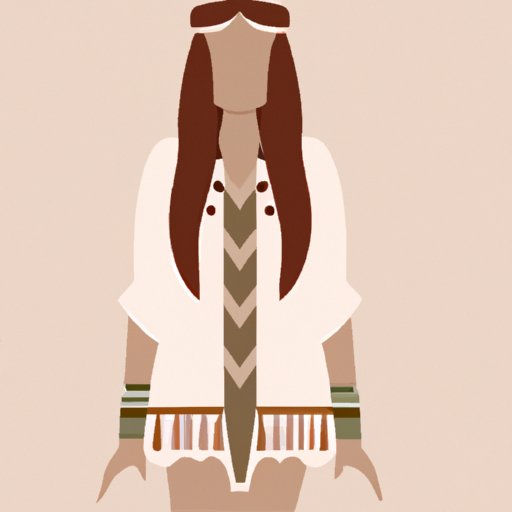Introduction
Cultural appropriation is an issue that has been widely discussed in recent years, as individuals and communities become increasingly aware of the impact their actions can have on others. As defined by Oxford Dictionary, cultural appropriation is “the unacknowledged or inappropriate adoption of the customs, practices, ideas, etc. of one people or society by members of another and typically more dominant people or society.” This definition implies that power dynamics are an important factor in understanding cultural appropriation, as the more dominant group often takes aspects of a culture without proper acknowledgement or respect for the original source.
The boho aesthetic is one of the most popular styles today, with many people embracing the look and feel of this trend. But what exactly is boho, and how does it relate to cultural appropriation? This article will explore the origins of the boho aesthetic, examine popular trends and assess whether these trends are appropriative or appreciative. Additionally, it will investigate the ethics of wearing boho-style fashion and reflect on the future of boho, looking at ways to redeem it from appropriation and prevent cultural appropriation in the future.
Exploring the Origins of the Boho Aesthetic and its Impact on Cultural Appropriation
The boho aesthetic originated in the late 1960s, with the hippie movement. During this time, the style was adopted by many young people who wanted to express their free-spirited attitudes and nonconformist values. The boho aesthetic was heavily influenced by traditional Mexican, Native American and Eastern cultures, incorporating elements such as embroidery, loose clothing and vibrant colors. This style has continued to evolve over time, becoming popular among many different groups and subcultures.
Unfortunately, the boho aesthetic has also been subject to cultural appropriation. As the trend has gained popularity, some people have adopted elements of the boho aesthetic without properly acknowledging or respecting the original sources. This can be seen in the way that some brands and retailers have used indigenous designs and patterns without crediting the originators, or in the way that people have adopted certain aspects of the boho aesthetic without having a deep understanding of the culture and history behind it.
Examining Boho Trends: Are They Appropriating or Celebrating?
As boho has grown in popularity, many fashion trends have emerged that incorporate elements of the aesthetic. Some of the most popular boho trends include maxi dresses, fringe jackets, embroidered tops, wide-leg trousers and layered jewelry. While these trends may seem harmless, it is important to consider whether they are appropriative or appreciative of the original sources.
For example, are the designs being used to pay homage to the originators or to simply capitalize on the trend? Are the materials being sourced ethically, or are they being produced in exploitative conditions? Are the prices of the garments reflective of the work that went into creating them? These are all important questions to ask when assessing whether a trend is appropriative or appreciative.
Understanding the Ethics of Wearing Boho: Is it Appropriative or Appreciative?
When it comes to the ethics of wearing boho-style fashion, there are both pros and cons to consider. On the one hand, wearing boho-style clothing can be a way to show appreciation for the cultures and histories behind the aesthetic. It can also help to support local artisans and craftspeople, as many of the garments are handmade using traditional techniques.
On the other hand, there are also ethical issues to consider. For example, some boho-style garments are made using materials that are not sourced ethically, or produced in exploitative conditions. Additionally, some people may be appropriating the boho aesthetic without having a deep understanding of the culture and history behind it. As such, it is important to be mindful of the implications of wearing boho-style fashion.
Reflecting on the Future of Boho: Can it be Redeemed from Appropriation?
It is clear that boho has been subject to cultural appropriation, but is it possible to redeem the aesthetic and prevent further appropriation? One way to do this is to be more mindful of where our clothes come from, and to support brands and retailers that are transparent about their sourcing and production processes. Additionally, we can make an effort to understand the cultures and histories behind the boho aesthetic, and to give credit to the originators of the designs and patterns.
Finally, we can take steps to raise awareness about cultural appropriation and its impact on indigenous cultures. By engaging in conversations about these issues, we can help to educate others and encourage them to be more mindful of their actions. Through these efforts, we can ensure that the boho aesthetic is celebrated, rather than appropriated.
Conclusion
In conclusion, it is important to consider the implications of wearing boho-style fashion. While the boho aesthetic has been subject to cultural appropriation, it is possible to redeem it from appropriation by taking steps to support ethical brands and retailers, understand the cultures and histories behind the aesthetic, and raise awareness about cultural appropriation. By doing so, we can ensure that the boho aesthetic is celebrated, rather than appropriated.
(Note: Is this article not meeting your expectations? Do you have knowledge or insights to share? Unlock new opportunities and expand your reach by joining our authors team. Click Registration to join us and share your expertise with our readers.)
